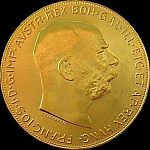
The Austrian 100 Corona coin is a good choice for investors looking to maximize the value of their gold investment purchase. Weighing just under an ounce, at 0.9802 ounces (gold content only), it is roughly comparable in size to the higher priced 1 ounce coins. Because it is no longer produced, and is not heavily marketed or promoted, the market demand is not as strong for this coin as it is for the common 1 ounce gold coins. Accordingly, the premium placed by the market on these coins over their gold content is generally less than for the full 1 ounce coins. This translates into a savings per ounce, i.e., more gold for your money.
As an example, under current market conditions, with gold trading at an ask spot price of $1,256.60 per ounce, Austrian 100 Coronas sell for approximately $1,283.10 each, reflecting a 4.2% premium over spot. One ounce Krugerrands, in contrast, sell for $1,336.80, a 6.4% premium over spot, and one ounce U.S. Eagles sell for $1,350.25, a 7.5% premium over spot. As an additional contrast, shares in the gold and silver-based Central Fund of Canada trade at a 9.2% premium over net asset value. The Austrian 100 Corona coin is a good value for serious investors in gold bullion.
The Austrian 100 Corona is also a very common coin among gold and silver dealers, and is widely recognized and easily purchased and sold. Investors can easily liquidate their holdings of Austrian 100 Coronas by selling them to dealers. The low premium paid on these coins is more easily recovered in an upswing of the gold market than the higher premiums on other coins.
These coins were minted originally in both Austria and Hungary between 1908 and 1914, but these earlier mintings are fairly rare. The most common Austrian 100 Corona coins on the market bear the date of 1915, and were minted as “re-strikes” starting in 1916 to commemorate the reign of Franz Josef I, Emperor of Austria and King of Hungary, who died that year.
These coins are 0.900 fine (21.6 karat), which means that they are relatively sturdy compared to 24 karat, or 0.999 fine coins. Since the purchase price and resale value of the coin only reflects the gold content, there is no real disadvantage to purchasing a coin with less than 99.9% purity. The advantage, though, is that they are more durable.
One drawback to this coin is that it is not a full ounce, and it requires a bit of math to figure out the estimated value per coin. This is a small inconvenience, though, for the potential savings to be had, and estimating its value is a simple matter of multiplying the current spot price by 0.9802, or checking out the Equivalents Page on our online Silver & Gold Payment Calculator.
Austrian Corona coins also come in lower denominations, which can work as “fractional” gold coins. The Austrian 20 Corona contains 0.1958 ounces (almost 0.2) , and the Austrian 10 Corona contains 0.0979 oz (almost 0.1).
So, to recap on the Austrian 100 Corona:
Advantages: Lower premium, higher durability, more gold for your money, good liquidity.
Disadvantages: “Non-standard” weight.
Related Reading:

